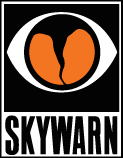 NWS Wakefield SKYWARN
NWS Wakefield SKYWARNAmateur Radio Support Team
WX4AKQ Wakefield, VA
SKYWARN Q&A
This page attempts to answer many of the frequently asked questions about our team and the SKYWARN program. If there's something you'd like to know that's not listed here, take a look at our Other Q&A Topics, check the SKYWARN Operations Manual, SKYWARN Training Portal, or send us an e-mail.
SKYWARN Behind the Scenes
What happens to reports I call in?
All reports are logged electronically in a system called the SKYWARN Report Management System, or RMS. RMS was built in-house from the ground up to collect and relay Spotter reports from amateur radio nets to the National Weather Service. It integrates electronically with six NWS offices and can also send reports to NWS Wakefield via packet and HF digital modes using the Winlink system.
Urgent reports, such as funnel clouds, rotating wall clouds, tornadoes, or significant storm damage, are relayed by telephone or radio as well.
Reports transmitted electronically generally go to the destination NWS office within 3 minutes, though each Net Control Operator has the option to push them out sooner. Once received at NWS, forecasters use this information, along with radar data and surface observations from electronic monitoring stations and other Spotters, to issue watches, warnings, and advisories (WWA) which are most appropriate for reported and forecasted conditions.
Do you keep my reports on file?
Yes. All reports called in to SKYWARN ham radio nets are logged electronically in RMS and stay on file permanently. We have all logged Spotter reports going back to the summer of 2008!
We use this data for a number of things.
First and foremost, it lets us keep track of how many reports we collect, and of those, how many met reporting criteria and were relayed to NWS. This helps us gauge the effectiveness of the SKYWARN training, especially when we filter reports by trained vs. non-trained Spotter.
We can see which Spotters are frequent contributors to our nets, and can use this information to send out recognition to our most active Spotters. We sometimes send out QSL-like postcards acknowledging particularly valuable reports, based on the information in our database.
We also look at historical report quality on an individual basis. Spotters which have a history of calling in an unusually high percentage of non-reportable weather events, or those who repeatedly call in suspicious or fraudulent reports can be targeted by SKYWARN ham radio team leadership and/or NWS personnel for additional training.
Who has access to reports in the RMS database?
All current SKYWARN Net Control Operators, SKYWARN Leadership Team personnel, NWS employees, and selected emergency management partners, including certain ARES/RACES officials, local and state emergency managers, and other EMCOMM leadership personnel, have access either through our internal log system or the semi-public SKYWARN Situation Awareness Dashboard.
I don't fall into one of those categories. Why can't I see the reports as they come in?
Our job is to collect reports from Spotters and relay those reports to the National Weather Service. NWS will screen those reports and will use those which they consider valid in the issuance of watch, warning, and advisory products.
Until the reports get to NWS, only minimal "sanity checking" has been performed. Individual reports can be wildly inaccurate, or can be taken out of context. We do make the raw report data available to certain emergency management partners because we can ensure these individuals are aware of the unscreened nature of the reports.
As a Spotter or member of the general public, you should be watching official NWS products for the latest severe weather information.
Can I take a tour of the Forecast Office?
Yes. Limited tours are available by contacting the WFO directly.